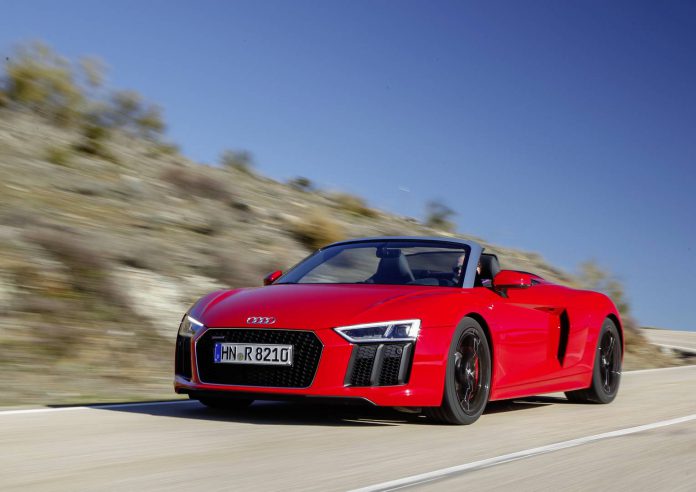Two years ago, this car may not have been possible: That’s when the performance division Audi Sport was still known as quattro GmbH. The great differentiation for this latest addition to the R8 lineup is the drivetrain: The R8 RWS does without all-wheel-drive. It is a pure rear-driver, and therefore, the sub-brand “Quattro” would have been a somewhat questionable fit.
With rear-wheel drive, the R8 RWS becomes an extreme sports car – one that can be driven lightly, but that has potential to be used as a true drifting tool. The 540 horsepower and 540 Nm of torque are fully transmitted to the rear axle, which is fitted with a mechanical locking differential.
And thus it can be steered not only by means of its ultra-precise electromechanical power steering that is now unhampered by the transmission of torque, but also with the right foot. This is a sensitive car, so we highly recommend you try it on a closed circuit first – or stick to the “Sport” setting of the stability control system, which allows for slight drifts without the risk of losing control entirely.
The R8 RWS weighs 1590 kilograms, a full 50 kilograms less than the quattro-equipped base model. It comes with a 41:59 weight transfer. The chassis has been sharpened: It is sportier than the base model and close to the character of the range-topping, 610-horsepower R8 Plus. The magnetorheological “Magnetic Ride” suspension is not available here.
Neither is the 610-horsepower engine, but the R8 RWS is easy game for the 540-horsepower unit as well. The sprint from 0 to 100 kph takes just 3.7 seconds, top speed is a nice and even 320 kph – which, by the way, are reached in sixth gear, not seventh.
It is impossible to top the linear power delivery of a naturally aspirated V-10; most competitors are now using downsized, turbocharged engines that don’t quite match the distinct character of this incredible powerplant. In fact, it evokes memories of what Formula One was like in its better times.
The seven-speed dual-clutch automatic is very quick and well-matched to the engine, but we still lament the passing of the six-speed manual with the second-gen R8. The open-gate manual would have been a perfect fit for the rear-whel drive RWS.
Ahead of the driver, there is a futuristic cockpit that hasn’t lost its fascinating appeal in the three years the car has been on the market. The TFT cluster is ultra-fast, the infotainment system is luxury-grade. The Alcantara seats are specific to the R8 RWS, but you can fit yours with racing seats as well.
Outside, the RWS is differentiated from its quattro siblings by means of its black 19-inch wheels on 245/35 front and 295/35 rear tires. And while the quattro models are fitted with contrast-coloured “blades,” the R8 RWS features a different look: The upper blade is coloured dark and looks like a continuation of the side window, while the lower element is body-coloured and thus vanishes visually.
Inside, there is a metal badge proclaiming the RWS is “1 of 999,” while failing to inform which number exactly it represents. The true individualist, we take it, needs to be content with the VIN (like everyone else).
Still, the badge is an attempt to resonate with a specific group of customers: The collectors of rare cars, which Audi Sport believes will find the R8 RWS especially appealing. The second group of prospective customers are serious drivers who prefer the agile character of a rear-driver. And we might add there is a third group of customers: The cost-conscious among R8 drivers (if there are any). After all, at EUR 140,000 (or EUR 153 000 for the Spyder), the limited-edition RWS is a whopping EUR 26 000 less expensive than the quattro-drive R8 base model with the same engine.
Go for it, we say. This is one of the most fun and interesting R8 models ever built.

































